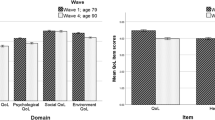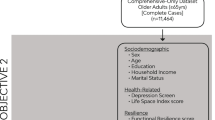Abstract
The hypothesis that the degree to which disease disrupts daily functioning is inversely associated with happiness is widely accepted, yet existing literature offers little direct evidence in its support. This paper explores the hypothesized association in a community-based sample of 383 older adults. To assess the degree to which disease disrupts daily functioning we developed a measure—called the freedom-from-debility score—based on four Short Form-12 (SF-12) Health Survey questions explicitly designed to represent “limitations in physical activities because of health problems” and “limitations in usual role activities because of physical health problems.” The results were consistent with the hypothesis. When participants were divided into categories based on their freedom-from-debility score, median happiness scores were monotonically increasing across categories. Controlling for demographic and socio-economic factors as well as health status (measured both subjectively and objectively), a one-point increase in freedom-from-debility score (on a scale from 0 to 100) was associated with a three-percent reduction in the odds of lower-quartile happiness. The results support the contention that health status is one of the most influential predictors of happiness, that the association between health status and happiness depends greatly on the manner in which health status is measured, and that the degree to which disease disrupts daily functioning is inversely associated with happiness.


Similar content being viewed by others
References
Angner, E., Ray, M., Saag, K., & Allison, J. (2009). Health and happiness among older adults: A community-based study. Journal of Health Psychology, 14(4), 503–512.
Antonak, R. F., & Livneh, H. (1995). Psychosocial adaptation to disability and its investigation among persons with multiple sclerosis. Social Science and Medicine, 40(8), 1099–1108.
Brickman, P., Coates, D., & Janoff-Bulman, R. (1978). Lottery winners and accident victims: Is happiness relative? Journal of Personality and Social Psychology, 36(8), 917–927.
Carel, H. (2009). “I am well, apart from the fact that I have cancer”: Explaining well-being within illness. In L. Bortolotti (Ed.), Philosophy and happiness (pp. 82–99). New York: Palgrave.
Çeliker, R., & Borman, P. (2001). Fibromyalgia versus rheumatoid arthritis: A comparison of psychological disturbance and life satisfaction. Journal of Musculoskeletal Pain, 9(1), 35–45.
Chuang, H. T., Devins, G. M., Hunsley, J., & Gill, M. J. (1989). Psychosocial distress and well-being among gay and bisexual men with human immunodeficiency virus infection. American Journal of Psychiatry, 146(7), 876–880.
Chwalisz, K., Diener, E., & Gallagher, D. (1988). Autonomic arousal feedback and emotional experience: Evidence from the spinal cord injured. Journal of Personality and Social Psychology, 54(5), 820–828.
Clarke, P. J., Ailshire, J. A., Nieuwenhuijsen, E. R., & de Kleign-de Vrankrijker, M. W. (2011). Participation among adults with disability: The role of the urban environment. Social Science and Medicine, 72(10), 1674–1684.
deHaes, J. C. J. M., & van Knippenberg, F. C. E. (1985). The quality of life of cancer patients: A review of the literature. Social Science and Medicine, 20(8), 809–817.
Diener, E., & Seligman, M. (2004). Beyond money: Toward an economy of well-being. Psychological Science in the Public Interest, 5(1), 1–31.
Eckersley, R., Dixon, J. M., Douglas, B., & Douglas, R. M. (2001). The social origins of health and well-being. Cambridge: Cambridge University Press.
Fava, G. A., & Sonino, N. (2008). The biopsychosocial model thirty years later. Psychotherapy and Psychosomatics, 77(1), 1–2.
Frederick, S., & Loewenstein, G. (1999). Hedonic adaptation. In D. Kahneman, E. Diener, & N. Schwarz (Eds.), Well-being: The foundations of hedonic psychology (pp. 302–329). New York: Russell Sage Foundation Press.
Friedsam, H. J., & Martin, H. W. (1963). A comparison of self and physicians’ health ratings in an older population. Journal of Health and Human Behavior, 4(3), 179–183.
Goldberg, R. T. (1974). Adjustment of children with invisible and visible handicaps: Congenital heart disease and facial burns. Journal of Counseling Psychology, 21(5), 428–432.
Green, G. A. (2001). Understanding NSAIDs: From aspirin to COX-2. Clinical Cornerstone, 3(5), 50–60.
Hébert, Réjean. (1997). Functional decline in old age. Canadian Medical Association Journal, 157(8), 1037–1045.
Hilbe, J. M. (2009). Logistic regression models. Boca Raton: CRC Press.
Johnson, J. P., McCauley, C. R., & Copley, J. B. (1982). The quality of life of hemodialysis and transplant patients. Kidney International, 22(3), 286–291.
Klonoff, P. S., Costa, L. D., & Snow, W. G. (1986). Predictors and indicators of quality of life in patients with closed-head injury. Journal of Clinical and Experimental Neuropsychology, 8(5), 469–485.
Larson, R. (1978). Thirty years of research on the subjective well-being of older Americans. Journal of Gerontology, 33(1), 109–125.
Lebo, D. (1953). Some factors said to make for happiness in old age. Journal of Clinical Psychology, 9(4), 385–387.
Livneh, H., & Antonak, R. F. (1994). Review of research on psychosocial adaptation to neuromuscular disorders: I. Cerebral palsy, muscular dystrophy, and Parkinson’s disease. Journal of Social Behavior and Personality, 9(5), 201–230.
Lucas, R. E. (2007). Adaptation and the set-point model of subjective well-being: Does happiness change after major life events? Current Directions in Psychological Science, 16(2), 75–79.
Lungenhausen, M., Lang, S., Maier, C., Schaub, C., Trampisch, H. J., & Endres, H. G. (2007). Randomised controlled comparison of the Health Survey Short Form (SF-12) and the Graded Chronic Pain Scale (GCPS) in telephone interviews versus self-administered questionnaires. Are the results equivalent? BMC Medical Research Methodology, 7(50), 1–8.
Lyubomirsky, S. (2001). Why are some people happier than others? The role of cognitive and motivational processes in well-being. American Psychologist, 56(3), 239–249.
Lyubomirsky, S., King, L., & Diener, E. (2005). The benefits of frequent positive affect: Does happiness lead to success? Psychological Bulletin, 131(6), 803–855.
Lyubomirsky, S., & Lepper, H. S. (1999). A measure of subjective happiness: Preliminary reliability and construct validation. Social Indicators Research, 46(2), 137–155.
Lyubomirsky, S., Tkach, C., & DiMatteo, M. R. (2006). What are the differences between happiness and self-esteem? Social Indicators Research, 78(3), 363–404.
Magilvy, J. K. (1985). Quality of life of hearing-impaired older women. Nursing Research, 34(3), 140–144.
Michalos, A. C., Zumbo, B. D., & Hubley, A. (2000). Health and the quality of life. Social Indicators Research, 51(3), 245–286.
Okun, M. A., & George, L. K. (1984). Physician-and self-ratings of health, neuroticism, and subjective well-being among men and women. Personality and Individual Differences, 5(5), 533–539.
Okun, M. A., Stock, W. A., Haring, M. J., & Witter, R. A. (1984). Health and subjective well-being. International Journal of Aging and Human Development, 19(2), 111–132.
Smith, C. A., & Wallston, K. A. (1992). Adaptation in patients with chronic rheumatoid arthritis: Application of a general model. Health Psychology, 11(3), 151–162.
Tyc, V. L. (1992). Psychosocial adaptation of children and adolescents with limb deficiencies: A review. Clinical Psychology Review, 12(3), 275–291.
Ware, J. E., & Sherbourne, C. D. (1992). The MOS 36-Item Short-Form Health Survey (SF-36). Medical Care, 30(6), 473–481.
Wood, R. L., & Rutterford, N. A. (2006). Demographic and cognitive predictors of long-term psychosocial outcome following traumatic brain injury. Journal of the International Neuropsychological Society, 12(3), 350–358.
Zautra, A., & Hempel, A. (1984). Subjective well-being and physical health. International Journal of Aging and Human Development, 19(2), 95–110.
Acknowledgments
This project was supported in part by the Agency for Healthcare Research and Quality (AHRQ) Centers for Education and Research on Therapeutics cooperative agreement (U18-HS010389).
Author information
Authors and Affiliations
Corresponding author
Appendices
Appendix 1: Debility questions from the SF-12
-
SF-2.
Think about moderate activities, such as moving a table, pushing a vacuum cleaner, bowling, or playing golf. Does your health now limit you a lot, limit you a little, or not limit you at all?
-
SF-3.
Think about climbing several flights of stairs. Does your health now limit you a lot, limit you a little, or not limit you at all?
-
SF-4.
During the past 4 weeks, how much of the time have you accomplished less than you would like as a result of your physical health?
-
SF-5.
During the past 4 weeks, how much of the time were you limited in the kind of work or regular daily activities you do as a result of your physical health?
Appendix 2: Happiness questions
-
1.
How happy do you consider yourself to be in general? 1 means that you do not consider yourself to be a very happy person and 7 means that you consider yourself to be a happy person.
-
2.
How do you compare your happiness to that of other people? 1 means that you are less happy than most people and 7 means that you are more happy than most people.
-
3.
Some people are generally very happy. They enjoy life regardless of what is going on, getting the most out of everything. How well does this describe you? 1 means that the statement does not describe you at all and 7 means that it describes you a great deal.
-
4.
Some people are generally not very happy. Although they are not depressed, they never seem as happy as they might be. How well does this describe you? 1 means that the statement does not describe you at all and 7 means that it describes you a great deal.
Rights and permissions
About this article
Cite this article
Angner, E., Ghandhi, J., Williams Purvis, K. et al. Daily Functioning, Health Status, and Happiness in Older Adults. J Happiness Stud 14, 1563–1574 (2013). https://doi.org/10.1007/s10902-012-9395-6
Published:
Issue Date:
DOI: https://doi.org/10.1007/s10902-012-9395-6




